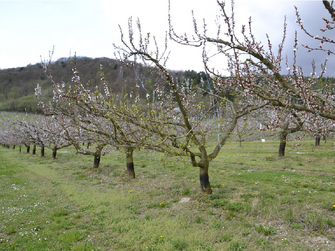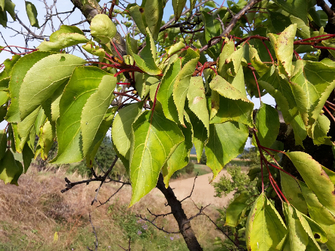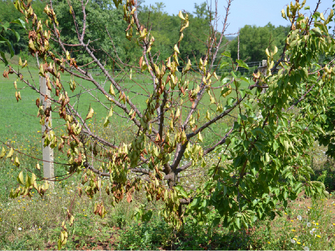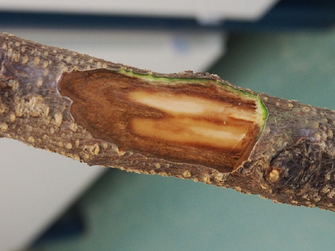Apricot chlorotic leafroll phytoplasma
Candidatus Phytoplasma prunorum
Profile
The disease, which is widespread in Europe, causes considerable economic damage to apricot, peach, cherry plum and Chinese plum. It is caused by the European Stone Fruit Yellows Phytoplasma (ESFY). This phytoplasmosis is considered to be one of the main causes of "sudden apricot strike" (apoplexy).
Biology
Phytoplasmas are transmitted by the plum leaf sucker(Cacopsylla pruni). These insects overwinter on conifers, from where they migrate to and infect stone fruit trees and Prunus wild shrubs (e.g., sloes) in early spring. The laid eggs give rise to a new generation of adult insects that ingest the phytoplasmas by sucking on infected plants. They soon leave the fruit trees and live on conifers until the next spring. During this time, the phytoplasmas multiply in the vectors, and these infective insects ensure the spread of the pathogens in the spring. The infected phloem of the host plants may die and clogs the conduit pathways by forming a polysaccharide (usually in winter). Death of the infected trees in spring is the result. The pathogens migrate to the roots in the fall, and above-ground plant parts are reinfected in the spring.
Damage symptoms
- Dieback of the screen parts (phloem necrosis), browning under the bark
- Yellowish (chlorotic) and upwardly curled leaves
- In peach, reddish discoloration between leaf veins
- Death of main branches or entire trees. Disease progression varies in speed depending on the susceptibility of the rootstock used, most severe on peach rootstocks
- Premature fruit ripening - small fruits with brownish, spongy flesh
- There may also be delayed flower formation (leaves appear in spring before flowers) and leaf rosette formation and increased opening of buds on perennial wood




Host plants
The main host plants are apricot(Prunus armeniaca), peach(P. persica), and Chinese plum(P. salicina).
However, symptoms are also found on sweet cherry(P. avium), almond(P. amygdalus), mirabelle(P. domestica spp. syriaca), and Japanese flowering cherry(P. serrulata).
Plum(P. domestica) and sloe are asymptomatic host plants.
The susceptibility of apricot depends strongly on the rootstock used: Highly susceptible are peach and apricot rootstocks, mid-susceptible are cherry-plum rootstocks (Myrobalane), relatively tolerant are plum rootstocks.
The pathogen also occurs on weed species such as field bindweed(Convolvulus arvensis) and bermudagrass(Cynodon dactylon).
Economic importance
European stone fruit yellowing is of economic importance in stone fruit growing. Especially in apricot cultivation, the disease leads to very high losses due to sudden impact (apoplexy, sudden death of the tree or branch sections). This usually occurs when the trees enter the yield phase.
Prevention and control
- Purchase of certified planting stock
- Use of less susceptible rootstocks or varieties.
- Vector treatment with authorised plant protection products (see list of plant protection products authorised in Austria)
- Regular infestation control
- Cut scions in winter, as the transmission rate is significantly higher during summer grafting
Last updated: 04.09.2024
automatically translated